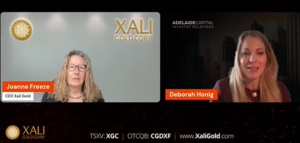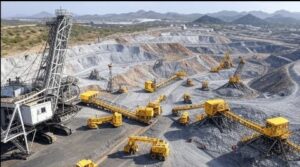Toronto, Ontario – (August 22, 2014) Argonaut Gold Inc. (“Argonaut”, “Argonaut Gold” or the “Company”; TSX: AR), announced today that the Company has a resource estimate resulting from the first phase of a multiple phase drill program at its 100% owned San Agustin project located 10 kilometres from Argonaut's El Castillo Mine (“El Castillo”) located in Durango, Mexico.
The San Agustin pit constrained indicated resource now stands at 845,000 gold ounces and 28,263,000 silver ounces contained in 82.2 million tonnes of material at a grade of 0.32 grams per tonne ("g/t") gold and 10.7 g/t silver, for a total of 1,280,000 gold equivalent ounces. The constrained pit resource has an additional inferred resource category of mineralization of 103,000 gold equivalent ounces including 65,000 contained gold ounces and 2,459,000 contained silver ounces within 7 million tonnes of material at a grade of 0.29 g/t gold and 11.0 g/t silver. The resource only includes oxide material and minimal transition material. The gold equivalent ounces are calculated utilizing a 65:1 gold price to silver price ratio and does not incorporate the recovery differential between gold and silver.
| Material Type | Class | Tonnes of Material (000s) | Gold Equivalent Grade (g/t) 1,2,3 | Gold Grade (g/t) | Silver Grade (g/t) | Gold Ounces Contained (000s) | Silver Ounces Contained (000s) |
| Oxide | Indicated | 79,373 | 0.37 | 0.32 | 10.6 | 817 | 27,050 |
| Transition | Indicated | 2,837 | 0.37 | 0.31 | 13.3 | 28 | 1,213 |
| Total | Indicated | 82,210 | 0.37 | 0.32 | 10.7 | 845 | 28,263 |
| Oxide | Inferred | 6,800 | 0.34 | 0.29 | 10.6 | 63 | 2,317 |
| Transition | Inferred | 164 | 0.35 | 0.23 | 26.9 | 1 | 142 |
| Total | Inferred | 6,964 | 0.34 | 0.29 | 11.0 | 65 | 2,459 |
1 g/t is grams per tonne
2 New resource based on a 0.18 g/t gold equivalent cut-off grade
3 The gold equivalent grade for the conceptual pit uses a 65:1 gold equivalent ounce ratio along with the metal recovery ratios achieved in the preliminary metallurgical test work
*Please see footnote Table 1 for the full Global Block Model Inventory table
Notes to Accompany Mineral Resource Table:
- Mineral resources are not mineral reserves and do not have demonstrated economic viability.
- Inferred mineral resources have a high degree of uncertainty as to their existence, and great uncertainty as to their economic and legal feasibility.
- Mineral resources are reported as undiluted.
- Mineral resources are reported within a conceptual pit shell.
- The resources are contained within a Lerchs-Grossmann pit shell based on $1,300/oz gold price, $20/oz silver price, mining cost of $1.00 per tonne ("/t") of material mined, process and general and administrative expense cost of $4.22/t with gold recoveries of 68% and silver recoveries of 21%.
- Tonnes, grade values, and contained metal quantities may differ due to rounding.
- Gold equivalent grade for conceptual pit used gold and silver price and recovery ratios.
A Phase II drill program, totaling 16,000 metres, will continue on the property with the objective of further expanding the resource area and testing additional targets within the Company's concession block.
CEO Commentary
Pete Dougherty, President and CEO of Argonaut Gold said “The San Agustin project is a very exciting opportunity for Argonaut. San Agustin is located approximately 10 kilometres from our main operating El Castillo mine; as such, there are many potential operational synergies between the two projects in terms of overlapping infrastructure and personnel.
We are very pleased with the work done on the San Agustin project to date. The Phase I drill program was completed ahead of schedule and under budget. This resource is only composed of oxide and transition material. Conceptually, the planned preliminary economic assessment (“PEA”) is intended to evaluate the San Agustin property as a heap leach operation. The upside potential to add mineralization by expanding the current resource area and assessing other defined targets immediately surrounding the resource is the primary focus for our ongoing drilling activities.
The new San Agustin resource represents an increase of more than 200% in indicated contained gold ounces in the oxides compared to the historic understanding of the property. The results from preliminary metallurgical work at San Agustin support recoveries similar to operational results experienced at our El Castillo mine, with overall gold recovery of 65% to 70%, and silver recovery of 16% to 24%, depending on crush size.
A high proportion of the global block model inventory was captured by the constrained resource pit. The near surface mineralization and continuity of material in the resource suggest a low strip ratio and the potential for robust economics for the project.
All of the necessary engineering work, base-line permitting studies, land acquisition and other activities are well underway. We anticipate that a PEA for the project will be completed by year-end.”
2014 San Agustin Drill Program Summary
The results from Phase I of the multiple phase drill program were incorporated into the resource block model for San Agustin with an effective date of July 8, 2014. Phase I drilling consisted of more than 22,000 metres at San Agustin. Reverse circulation (“RC”) drilling includes 21,115 metres in 217 holes that were used to estimate resources; PQ core drilling includes nearly 1,000 metres in 13 holes used for metallurgical testwork.
| Phase I | |||
| RC | CORE | RC + CORE | |
| Completed Drill Holes | 217 | 13 | 230 |
| Completed Metres | 21,115 | 999 | 22,114 |
The Company has planned for additional work and drilling to be conducted on the property. Currently, a Phase II drill program of 16,000 metres to expand the mineralization on the northwest portion of our current concessions has been approved. The drilling will continue after securing expanded exploration permits.
Tom Burkhart, Vice President of Exploration for the Company, said “The San Agustin project remains the core focus for the Argonaut Gold exploration team during 2014. The potential for expanding the resource is a high priority for the Company. While only the Phase I drilling is being incorporated into this resource estimate, targets of interest exist on our current concession as well as the concessions recently acquired from Geologix Explorations Inc. If our ongoing drilling campaign directed at resource expansion and additional target assessment is successful, an increase in the drilling budget will be warranted.”
For complete results from the Phase I drilling campaign please see the press release dated July 15, 2014. In addition, the results from the drilling campaign are posted on the Company's website at www.argonautgold.com.
San Agustin National Instrument 43-101 ("NI 43-101") Resources
In connection with this announcement, Argonaut plans to file a technical report for the San Agustin project, pursuant to NI 43-101 of the Canadian Securities Administrators. The report is being prepared by Resource Modeling Inc. (“RMI”) based out of Stites, Idaho.
San Agustin Resource Map

San Agustin Resource Pit Outline

San Agustin Block Model Cross Section 1

San Agustin Block Model Cross Section 2

San Agustin Block Model Cross Section 3

Footnotes
Table 1: San Agustin Block Model Inventory Effective Date July 8, 2014
| Material Type | Class | Tonnes of Material (000s) | Gold Equivalent Grade (g/t) | Gold Grade (g/t) | Silver Grade (g/t) | Gold Ounces Contained (000s) | Silver Ounces Contained (000s) |
| Oxide | Indicated | 79,783 | 0.37 | 0.32 | 10.5 | 821 | 26,933 |
| Transition | Indicated | 3,136 | 0.36 | 0.30 | 12.6 | 30 | 1,270 |
| Total Resource | Indicated | 82,919 | 0.37 | 0.32 | 10.6 | 851 | 28,204 |
| Oxide | Inferred | 11,072 | 0.31 | 0.26 | 9.6 | 93 | 3,417 |
| Transition | Inferred | 710 | 0.27 | 0.20 | 13.7 | 5 | 313 |
| Total Resource | Inferred | 11,782 | 0.31 | 0.26 | 9.8 | 97 | 3,730 |
Summary of Estimation Methodology
The new San Agustin mineral resource is based on 520 drill holes totaling approximately 80,760 metres of drilling which includes results from Argonaut's 2014 phase I drilling program. Approximately one third of the drill hole data was obtained by core drilling methods and the remainder generated by reverse circulation methods. The drill hole spacing within the mineral resource area is approximately 40 metres.
Argonaut's geologic staff generated three-dimensional lithologic and oxidation wireframes using Leapfrog® software. Those shapes were reviewed by RMI and used to code 6 metres x 6 metres x 6 metres blocks using MineSight® software. In addition to lithologic and oxidation shapes, two distinct structural domains were identified by Argonaut and utilized by RMI in the grade estimation plan. High-grade gold and silver outliers were identified for each primary lithologic unit using cumulative probability plots. The high-grade outlier assay values were capped prior to creating 6 metre long drill hole composites that were used to estimate block grades.
Gold and silver block grades were estimated using a two-pass inverse distance squared method. Northwest and northeast trending search ellipses were used for the western and eastern structural domains, respectively. The block grades were validated using visual and statistical methods. It is RMI's opinion that the grade models are globally unbiased.
A three-dimensional wireframe based on mineralized continuity was used to classify a portion of the estimated blocks as indicated resources. The remainder of the estimated blocks were classified as inferred resources, provided the distance to the closest drill hole was less than 60 metres. Mineral resources were constrained by a conceptual Lerchs-Grossmann pit that used reasonable metal prices, costs, recoveries, and pit slopes. Table 2 summarizes results from a series of conceptual pits that were generated using different gold and silver prices.
Table 2: Conceptual pit resource quantities based on different gold and silver prices
| Au and Ag Prices for Conceptual Pits 1 | AuEQV Cutoff (g/t) 2 | Total Indicated Resources (Oxide+Transition) | |||||
| Tonnes (000) | AuEQV (g/t) | Au (g/t) | Ag (g/t) | Contained Ozs (000) | |||
| Au Ozs | Ag Ozs | ||||||
| $1500 Au $23.00 Ag | 0.16 | 89,734 | 0.35 | 0.31 | 10.2 | 892 | 29,382 |
| $1400 Au $21.50 Ag | 0.17 | 86,156 | 0.36 | 0.31 | 10.4 | 858 | 28,780 |
| $1300 Au $20.00 Ag | 0.18 | 82,210 | 0.37 | 0.32 | 10.7 | 845 | 28,263 |
| $1200 Au $18.50 Ag | 0.20 | 75,118 | 0.39 | 0.33 | 11.1 | 796 | 26,827 |
| $1100 Au $17.00 Ag | 0.22 | 67,078 | 0.40 | 0.35 | 11.6 | 753 | 25,061 |
| Au and Ag Prices for Conceptual Pits | AuEQV Cutoff (g/t) | Total Inferred Resources (Oxide+Transition) | |||||
| Tonnes (000) | AuEQV (g/t) | Au (g/t) | Ag (g/t) | Contained Ozs (000) | |||
| Au Ozs | Ag Ozs | ||||||
| $1500 Au $23.00 Ag | 0.16 | 10,261 | 0.30 | 0.25 | 9.9 | 82 | 3,259 |
| $1400 Au $21.50 Ag | 0.17 | 8,633 | 0.32 | 0.27 | 10.5 | 75 | 2,922 |
| $1300 Au $20.00 Ag | 0.18 | 6,964 | 0.34 | 0.29 | 11.0 | 65 | 2,459 |
| $1200 Au $18.50 Ag | 0.20 | 5,261 | 0.36 | 0.31 | 12.3 | 52 | 2,080 |
| $1100 Au $17.00 Ag | 0.22 | 3,740 | 0.40 | 0.34 | 13.9 | 41 | 1,672 |
1 Au means gold and Ag means silver. The same costs and recoveries applied to all material.
2 Calculated break-even Au equivalent cutoff grade based on costs, prices, and recoveries.
Table 3: Preliminary metallurgical test results from the San Agustin project
Preliminary metallurgical test work was conducted by Kappes, Cassiday & Associates (“KCA”), based out of Reno, Nevada. Metallurgical recoveries indicate an overall gold recovery ranging between 65-70% and overall silver recovery ranging between 16%-24%, depending on crush size.
Summary of the preliminary metallurgical test work parameters are included below:
- Column tests run at a crush size of 50 mm and 12.5 mm.
- Total test leach cycle of 73 days.
- The preliminary results indicate that gold recoveries are impacted by crush size, with a smaller crush size of 12.5 mm providing an average recovery of 70%, compared to 50 mm crush sizes providing an average recovery of 65%.
- Preliminary metallurgical work will continue with the expectation that the final results to be included in the preliminary economic assessment estimated to be completed by the end of the year.
| Sample Description | Crush Size, mm 100% Passing | Recovery Percentage | |
| Au | Ag | ||
| Average – All | 50 | 65% | 16% |
| Average – All | 12.5 | 70% | 24% |
| KCA estimates that field heap cyanide consumption will be approximately 30% of the lab test consumptions. | |||
Full table of preliminary KCA metallurgical work results
| Sample Description | Crush Size, mm 100% Passing | Head Grade | Recovery Percentage | Leach Time Days | Lime Consumption kg/t5 | Cyanide Consumption kg/t | ||
| Au g/t | Ag g/t | Au | Ag | |||||
| SA 1 – Dacite | 50 | 0.301 | 13.26 | 46% | 12% | 73 | 4.1 | 0.17 |
| SA 2 – Dacite | 50 | 0.508 | 19.67 | 81% | 12% | 73 | 4.1 | 0.31 |
| SA 3 – Sediments | 50 | 0.612 | 8.68 | 66% | 19% | 73 | 4.2 | 0.70 |
| SA 4 – Dacite | 50 | 0.492 | 5.95 | 70% | 18% | 73 | 4.2 | 0.54 |
| SA 5 – Dacite | 50 | 0.385 | 5.71 | 56% | 17% | 73 | 4.1 | 0.68 |
| SA 6 – Dacite High Grade | 50 | 4.179 | 39.85 | 72% | 17% | 73 | 4.3 | 0.65 |
| Average – All | 50 | 65% | 16% | 4.2 | 0.51 | |||
| 5 kg/t is kilograms/tonne KCA estimates that field heap cyanide consumption will be approximately 30% of the lab test consumptions. | ||||||||
| Sample Description | Crush Size, mm 100% Passing | Head Grade | Recovery Percentage | Leach Time Days | Lime Consumption kg/t | Cyanide Consumption kg/t | |||
| Au g/t | Ag g/t | Au | Ag | ||||||
| SA 1 – Dacite | 12.5 | 0.344 | 11.59 | 50% | 24% | 73 | 4.1 | 0.34 | |
| SA 2 – Dacite | 12.5 | 0.516 | 16.84 | 84% | 18% | 73 | 4.1 | 0.43 | |
| SA 3 – Sediments | 12.5 | 0.632 | 8.57 | 74% | 28% | 73 | 4.2 | 0.75 | |
| SA 4 – Dacite | 12.5 | 0.512 | 5.39 | 75% | 25% | 73 | 4.1 | 0.64 | |
| SA 5 – Dacite | 12.5 | 0.363 | 4.75 | 68% | 24% | 73 | 4.1 | 0.80 | |
| SA 6 – Dacite High Grade | 12.5 | 4.609 | 45.50 | 71% | 22% | 73 | 4.2 | 0.80 | |
| Average – All | 12.5 | 70% | 24% | 4.1 | 0.63 | ||||
KCA estimates that field heap cyanide consumption will be approximately 30% of the lab test consumptions.
Qualified Person Comments/Quality Control Procedures
The preparation of this Press Release was supervised and approved by Thomas Burkhart, Argonaut Gold’s Vice President of Exploration and a Qualified Person under NI 43-101. Mr. Burkhart also reviewed the reverse circulation and core drilling programs and on-site sample preparation procedures at San Agustin.
Mr. Mike Lechner of RMI located in Stites, Idaho who is an “Independent Qualified Person” as defined by NI 43-101 and the lead person responsible for completing the new San Agustin resource has reviewed this press release as it relates to the San Agustin project.
Mr. Carl Defilippi of KCA located in Reno, Nevada who is an “Independent Qualified Person” as defined by NI 43-101 and the lead person responsible for completing the metallurgical work for the new San Agustin resource has reviewed this press release as it relates to the San Agustin project.
For sample analysis the Company utilizes a system of Quality Assurance/Quality Control that includes insertion and verification of standards, blanks and duplicates consistent with industry standards.
Samples from the San Agustin Project are collected at site by Argonaut’s personnel and transported to ALS-Chemex preparation laboratory in Zacatecas, where samples are prepared and pulps sent for assay in ALS-Chemex’s Vancouver, BC laboratory. Samples are analyzed for gold by Fire Assay and Atomic absorption finish (Au-AA23 assay code; 0.005 to 10 ppm detection limit) plus Silver by Aqua Regia and Atomic Absorption finish (0.1 to 200 ppm detection limit). Samples over 10 g/t Au are assayed with gravimetric finish (Assay code Au-GRA21). All samples are also assayed by ICP-AES (code ME-ICP41) for a suite of 35 elements.
Argonaut is not aware of any legal, political, environmental or other risks that could materially affect the potential development of the mineral resource other than those set out in its annual information form filed on www.sedar.com. Please see below under the heading "cautionary note regarding forward-looking financial information" for further details regarding risks facing Argonaut.
About Argonaut Gold
Argonaut Gold is a Canadian gold company engaged in exploration, mine development and production activities. Its primary assets are the production stage El Castillo mine in Durango, Mexico, and the La Colorada mine in Sonora, Mexico. Advanced exploration stage projects include the San Antonio project in Baja California Sur, Mexico, the San Agustin project in Durango, Mexico and the Magino project in Ontario, Canada. The recently acquired San Agustin project is the primary exploration target for Argonaut in 2014. The Company also has several exploration stage projects, all of which are located in North America.
Creating Value Beyond Gold
Cautionary Note Regarding Forward-looking Statements
This press release contains certain “forward-looking statements” and “forward-looking information” under applicable Canadian securities laws concerning the business, operations and financial performance and condition of Argonaut Gold Inc. (“Argonaut” or “Argonaut Gold”). Forward-looking statements and forward-looking information include, but are not limited to, statements with respect to estimation of mineral resources at mineral projects of Argonaut; ; the realization of mineral reserve estimates; the timing and amount of estimated future production; economics of production; success of exploration activities; estimated production and mine life of the various mineral projects of Argonaut; the future price of gold and silver; synergies and financial impact of completed acquisitions; the benefits of the development potential of the properties of Argonaut and currency exchange rate fluctuations. Except for statements of historical fact relating to Argonaut, certain information contained herein constitutes forward-looking statements. Forward-looking statements are frequently characterized by words such as “plan,” “expect,” “project,” “intend,” “believe,” “anticipate”, “estimate” and other similar words, or statements that certain events or conditions “may” or “will” occur. Forward-looking statements are based on the opinions and estimates of management at the date the statements are made, and are based on a number of assumptions and subject to a variety of risks and uncertainties and other factors that could cause actual events or results to differ materially from those projected in the forward-looking statements. Many of these assumptions are based on factors and events that are not within the control of Argonaut and there is no assurance they will prove to be correct.
Factors that could cause actual results to vary materially from results anticipated by such forward-looking statements include variations in metal grades, changes in market conditions, variations in recovery rates, risks relating to international operations, fluctuating metal prices and currency exchange rates, changes in project parameters, the possibility of project cost overruns or unanticipated costs and expenses, labour disputes and other risks of the mining industry, failure of plant, equipment or processes to operate as anticipated.
These factors are discussed in greater detail in Argonaut's most recent Annual Information Form and in the most recent Management Discussion and Analysis filed on SEDAR, which also provide additional general assumptions in connection with these statements. Argonaut cautions that the foregoing list of important factors is not exhaustive. Investors and others who base themselves on forward-looking statements should carefully consider the above factors as well as the uncertainties they represent and the risk they entail. Argonaut believes that the expectations reflected in those forward-looking statements are reasonable, but no assurance can be given that these expectations will prove to be correct and such forward-looking statements included in this press release should not be unduly relied upon. These statements speak only as of the date of this press release. Argonaut undertakes no obligation to update forward-looking statements if circumstances or management’s estimates or opinions should change except as required by applicable securities laws.
Although Argonaut has attempted to identify important factors that could cause actual actions, events or results to differ materially from those described in forward-looking statements, there may be other factors that cause actions, events or results not to be anticipated, estimated or intended. Statements concerning mineral reserve and resource estimates may also be deemed to constitute forward-looking statements to the extent they involve estimates of the mineralization that will be encountered if the property is developed.
For more information, contact:
Argonaut Gold Inc.
Nichole Cowles
Investor Relations
Tel: (775) 284-4422 x 101
Email: nichole.cowles@argonautgold.com
www.argonautgold.com
















